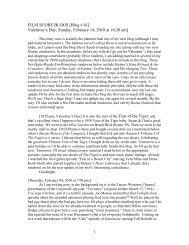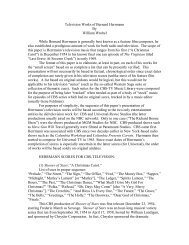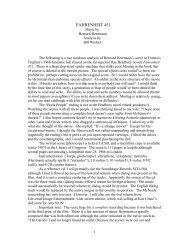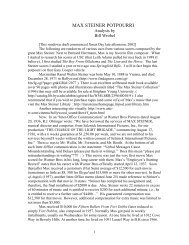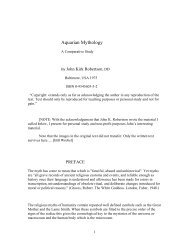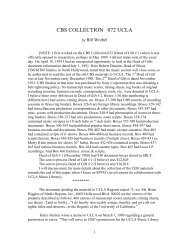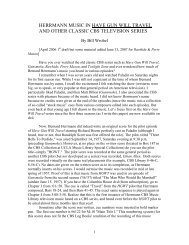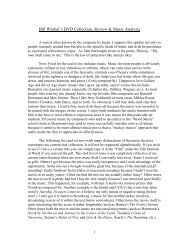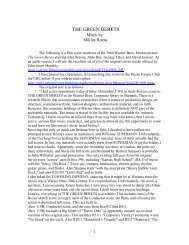TEMPO MARKINGS OF BERNARD HERRMANN SCORES ...
TEMPO MARKINGS OF BERNARD HERRMANN SCORES ...
TEMPO MARKINGS OF BERNARD HERRMANN SCORES ...
Create successful ePaper yourself
Turn your PDF publications into a flip-book with our unique Google optimized e-Paper software.
what prior speed? In this case, it is Lento but it could very well have been Moderato or<br />
even Allegro.<br />
In the overwhelmingly number of entries, Herrmann inserted the traditional<br />
Italian-named tempo markings, but many with creative variations or additions (tempo<br />
adornments). Of course the most-used tempo marking was the unadorned Lento marking.<br />
Of my large representative sampling (again, most of Herrmann’s scores), he used about<br />
480 unadorned Lento markings (or 13.7% of the total). Next would be the unadorned<br />
Moderato at about 350 entries of the approximately 3,500 entries (or 10% of the total).<br />
Next in frequency was Slow (of course not Italian!) at about 155 or 4.4 %. Slow has the<br />
same overall basic meaning (and speed) as Lento, incidentally, as indicated by the<br />
metronome markings (as I’ll delineate shortly). Next in frequency is the unadorned Largo<br />
at about 121 entries (3.5 %). Largo is slower in tempo than Lento, or about 40-50 BPM<br />
(Beats Per Minute). Next in frequency is the unadorned Allegro of about 115 entries (or<br />
3.3 %). Next in frequency is Slowly of about 86 entries (or 2.5 %). Slowly is generally a<br />
bit slower (in Herrmann’s metronome indications) than Slow (or 50-60). Finally the<br />
unadorned Andante has about 71 entries or 2%.<br />
Whenever available, I included in each entry the m.m. or metronome marking that<br />
Herrmann entered. Alas, this was quite infrequent. I estimate that of my 3,500 entries,<br />
only about 6% (about 200 entries) had metronome indications. He tended to put more<br />
m.m. numbers on his feature film scores than on his television scores, and practically<br />
none in his radio scores (such as Crime Classics where I believe only two, maybe three,<br />
scores had m.m. indications). Metronome markings would be essential to gauge the<br />
actual (scientific) speed of a cue or section of a cue, although back in Herrmann’s period<br />
there was no digital click timings. Moreover, remember that these m.m. indications are<br />
Herrmann’s own and, like the descriptive tempo markings, were approximations, ever<br />
varying. For example, Moderato m/m. indications (of about 45 entries that I have)<br />
showed a range from 60-80 b.p.m. Allegro ranged from 120-160 (but overwhelmingly at<br />
120). Lento was almost always consistently at 60 b.p.m. (as annotated by Herrmann).,<br />
and Maestoso ranged from 60-70 (usually 60). Largo ranged from 40-50 b.p.m. (edging<br />
towards 40). Molto Pesante (and its derivatives) usually were at 60 b.p.m.. Slow ranged<br />
from 50-60, although normally placed at 60, whereas the small sample of Slowly and<br />
Very Slowly was usually at 50. Allegro Moderato ranged the most from 60-120 (no<br />
weighting on any particular speed). Vivo in my very small sample was normally at 120<br />
b.p.m.<br />
Different texts give different ranges of speed for tempo markings. Normally we<br />
have the followed standard and oft-used markings (from slowest to fastest):<br />
Largo to Lento to Adagio to Andante to Moderato to Allegro to Allegretto to Presto<br />
Some texts (such as Grant’s Handbook of Music Terms) bestow Adagio as slower<br />
than Lento. Some texts give Lento a 50-66 range, while others give a 40-56 range, and so<br />
forth. Andante is given a 72-88 range, while other texts attribute a range of 76-108, etc.<br />
Some texts give a range of 108-120 to Moderato while others feel that 85-95 is more the<br />
real range. The same variation tends to apply to the meanings of the descriptive tempo<br />
markings. Adagio is sometimes referred to as slow or even very (quite) slow to<br />
moderately slow and leisurely. Andante is often spoken of as being moderate (but rather<br />
2




